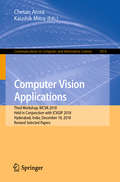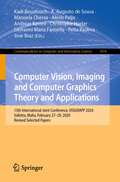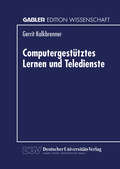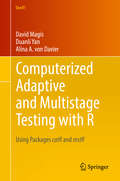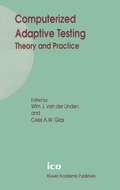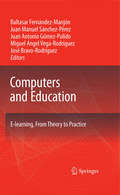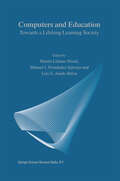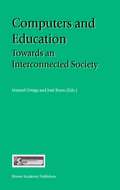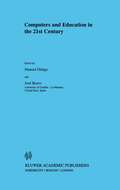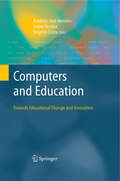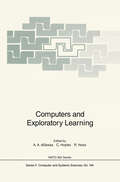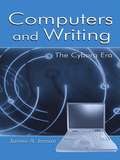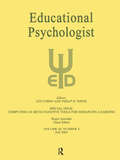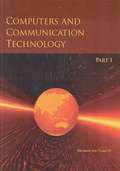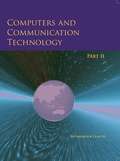- Table View
- List View
Computer Vision and Image Processing: 5th International Conference, CVIP 2020, Prayagraj, India, December 4-6, 2020, Revised Selected Papers, Part II (Communications in Computer and Information Science #1377)
by Satish Kumar Singh Partha Roy Balasubramanian Raman P. NagabhushanThis three-volume set (CCIS 1367-1368) constitutes the refereed proceedings of the 5th International Conference on Computer Vision and Image Processing, CVIP 2020, held in Prayagraj, India, in December 2020. Due to the COVID-19 pandemic the conference was partially held online. The 134 papers papers were carefully reviewed and selected from 352 submissions. The papers present recent research on such topics as biometrics, forensics, content protection, image enhancement/super-resolution/restoration, motion and tracking, image or video retrieval, image, image/video processing for autonomous vehicles, video scene understanding, human-computer interaction, document image analysis, face, iris, emotion, sign language and gesture recognition, 3D image/video processing, action and event detection/recognition, medical image and video analysis, vision-based human GAIT analysis, remote sensing, and more.
Computer Vision and Image Processing: 5th International Conference, CVIP 2020, Prayagraj, India, December 4-6, 2020, Revised Selected Papers, Part I (Communications in Computer and Information Science #1376)
by Satish Kumar Singh Partha Roy Balasubramanian Raman P. NagabhushanThis three-volume set (CCIS 1367-1368) constitutes the refereed proceedings of the 5th International Conference on Computer Vision and Image Processing, CVIP 2020, held in Prayagraj, India, in December 2020. Due to the COVID-19 pandemic the conference was partially held online. The 134 papers papers were carefully reviewed and selected from 352 submissions. The papers present recent research on such topics as biometrics, forensics, content protection, image enhancement/super-resolution/restoration, motion and tracking, image or video retrieval, image, image/video processing for autonomous vehicles, video scene understanding, human-computer interaction, document image analysis, face, iris, emotion, sign language and gesture recognition, 3D image/video processing, action and event detection/recognition, medical image and video analysis, vision-based human GAIT analysis, remote sensing, and more.
Computer Vision Applications: Third Workshop, WCVA 2018, Held in Conjunction with ICVGIP 2018, Hyderabad, India, December 18, 2018, Revised Selected Papers (Communications in Computer and Information Science #1019)
by Chetan Arora Kaushik MitraThis book constitutes the refereed proceedings of the third Workshop on Computer Vision Applications, WCVA 2018, held in Conjunction with ICVGIP 2018, in Hyderabad, India, in December 2018. The 10 revised full papers presented were carefully reviewed and selected from 32 submissions. The papers focus on computer vision; industrial applications; medical applications; and social applications.
Computer Vision, Imaging and Computer Graphics Theory and Applications: 15th International Joint Conference, VISIGRAPP 2020 Valletta, Malta, February 27–29, 2020, Revised Selected Papers (Communications in Computer and Information Science #1474)
by Petia Radeva Giovanni Maria Farinella Andreas Kerren Christophe Hurter Manuela Chessa Kadi Bouatouch Alexis Paljic A. Augusto de Sousa Jose BrazThis book constitutes thoroughly revised and selected papers from the 15th International Joint Conference on Computer Vision, Imaging and Computer Graphics Theory and Applications, VISIGRAPP 2020, held in Valletta, Malta, in February 2020.The 25 thoroughly revised and extended papers presented in this volume were carefully reviewed and selected from 455 submissions. The papers contribute to the understanding of relevant trends of current research on computer graphics; human computer interaction; information visualization; computer vision.
Computergestütztes Lernen und Teledienste
by Gerrit KalkbrennerFür computergestütztes Lernen ergeben sich aus der Weiterentwicklung der multimedialen Fähigkeiten von Computern und ihrer breitbandigen Vernetzung neue Freiräume der Gestaltung, insbesondere für die Veranschaulichung von dynamischen Vorgängen.
Computerized Adaptive and Multistage Testing with R: Using Packages catR and mstR (Use R!)
by David Magis Duanli Yan Alina A. von DavierThe goal of this guide and manual is to provide a practical and brief overview of the theory on computerized adaptive testing (CAT) and multistage testing (MST) and to illustrate the methodologies and applications using R open source language and several data examples. Implementation relies on the R packages catR and mstR that have been already or are being developed by the first author (with the team) and that include some of the newest research algorithms on the topic. The book covers many topics along with the R-code: the basics of R, theoretical overview of CAT and MST, CAT designs, CAT assembly methodologies, CAT simulations, catR package, CAT applications, MST designs, IRT-based MST methodologies, tree-based MST methodologies, mstR package, and MST applications. CAT has been used in many large-scale assessments over recent decades, and MST has become very popular in recent years. R open source language also has become one of the most useful tools for applications in almost all fields, including business and education. Though very useful and popular, R is a difficult language to learn, with a steep learning curve. Given the obvious need for but with the complex implementation of CAT and MST, it is very difficult for users to simulate or implement CAT and MST. Until this manual, there has been no book for users to design and use CAT and MST easily and without expense; i.e., by using the free R software. All examples and illustrations are generated using predefined scripts in R language, available for free download from the book's website.
Computerized Adaptive Testing: Theory and Practice
by Cees A. W. Glas Wim J. Van Der LindenThis book offers a comprehensive introduction to the latest developments in the theory and practice of CAT. It can be used both as a basic reference and a valuable resource on test theory. It covers such topics as item selection and ability estimation, item pool development and maintenance, item calibration and model fit, and testlet-based adaptive testing, as well as the operational aspects of existing large-scale CAT programs.
Computers and Education: E-Learning, From Theory to Practice
by Baltasar Fernández-Manjón José Bravo-Rodríguez Juan Antonio Gómez-Pulido Juan Manuel Sánchez-Pérez Miguel Angel Vega-RodríguezThis book contains a selection of contributions presenting the latest research in the field of computers in education and, more specifically, in e-Learning. It reflects the diverse scenario of the application of computers in the educational field by describing previous experiences and addressing some of the present key issues. These include issues such as Learning Management Systems as well as innovative aspects such as personalized or ubiquitous learning.
Computers and Education: Towards a Lifelong Learning Society
by Luis E.Anido-Rifon Manuel J.Fernández-Iglesias MartínLlamas-NistalThis volume contains a selection of papers on the most up-to-date experiences in the field of computers and education. It includes most relevant case studies and novel research results addressing technical and methodological aspects of computers and educations. It is relevant to researchers, practitioners, teaching staff and developers working in e-learning, computer-based education, educational software, distributed learning, lifelong learning, and open and distance learning.
Computers and Education in the 21st Century
by Manuel OrtegaConieD is the biannual Congress on Computers in Education, organised by the Spanish Association for the Development of Computers in Education (ADIE). The last Congress, held in Puertollano (Ciudad Real), brought together researchers in different areas, ranging from web applications, educational environments, or Human-Computer Interaction to Artificial Intelligence in Education. The common leitmotiv of the major part of the lectures was the World Wide Web. In particular, the focus was on the real possibilities that this media presents in order to make the access of students to educational resources possible anywhere and anytime. This fact was highlighted in the Conclusions of the Congress following this Preface as the Introduction. From the full 92 papers presented to the Programme Committee we have selected the best 24 papers that we are presenting in this book. The selection of papers was a very difficult process, taking into account that the papers presented in the Congress (60) were all good enough to appear in this book. Only the restrictions of the extension of this book have limited the number of papers to 24. These papers represent the current high-quality contributions of Spanish research groups in Computers in Education. Manuel Ortega Cantero José Bravo Rodríguez Editors xiii Introduction ConieD’99 (1st National Congress on Computers in Education) has brought together a very important group of Spanish and Latin American researchers devoted to studying the application and use of computers in education.
Computers and Education: Towards Educational Change and Innovation
by António José Mendes Isabel Pereira Rogério CostaDiscover the latest research on the application of information and communication technologies (ICTs) in the field of education. Among the many areas covered, the book examines the latest innovations in the design, development, and evaluation of innovative educational environments. You’ll also discover how ICTs support special education, collaborative learning, and distance learning. Finally, key social aspects of ICTs in education are examined.
Computers and Exploratory Learning (NATO ASI Subseries F: #146)
by L. D. EdwardsComputers are playing a fundamental role in enhancing exploratory learning techniques in education. This volume in the NATO Special Programme on Advanced Educational Technology covers the state of the art in the design and use of computer systems for exploratory learning. Contributed chapters treat principles, theory, practice, and examples of some of the best contemporary computer-based learning environments: Logo, Boxer, Microworlds, Cabri-Géomètre, Star Logo, Table Top, Geomland, spreadsheets, Function Machines, and others. Emphasis is on mathematics and science education. Synthetic chapters provide an overview of the current scene in computers and exploratory learning, and analyses from the perspectives of epistemology, learning, and socio-cultural studies.
Computers and the Collaborative Experience of Learning (Routledge Revivals)
by Charles CrookOriginally published in 1994. Until this book was published, the application of computers to educational practice has received little input from psychological theory. Computers and the Collaborative Experience of Learning locates this topic within the contemporary movement of socio-cultural theory, drawing on the writing of Vygotsky and others. Charles Crook reviews psychological approaches to cognition and learning, in so far as they implicitly direct strategy in respect of computer-based learning. He also takes a novel stance in considering how new technology can enhance rather than undermine the social experience of learning and instruction, and can allow teachers to achieve more in the classroom. He argues that computers can provide the conditions for effective collaboration and enhance the social dimension of education. With its unique blend of theory and practice, from the primary school to university settings, Computers and the Collaborative Experience of Learning will be of interest to educational psychologists, as well as psychologists studying group processes, cognition and development.
Computers and the Collaborative Experience of Learning (Routledge Revivals)
by Charles CrookOriginally published in 1994. Until this book was published, the application of computers to educational practice has received little input from psychological theory. Computers and the Collaborative Experience of Learning locates this topic within the contemporary movement of socio-cultural theory, drawing on the writing of Vygotsky and others. Charles Crook reviews psychological approaches to cognition and learning, in so far as they implicitly direct strategy in respect of computer-based learning. He also takes a novel stance in considering how new technology can enhance rather than undermine the social experience of learning and instruction, and can allow teachers to achieve more in the classroom. He argues that computers can provide the conditions for effective collaboration and enhance the social dimension of education. With its unique blend of theory and practice, from the primary school to university settings, Computers and the Collaborative Experience of Learning will be of interest to educational psychologists, as well as psychologists studying group processes, cognition and development.
Computers and Writing: The Cyborg Era
by James A. InmanIn this book, James A. Inman explores the landscape of the contemporary computers and writing community. Its six chapters engage critical issues, including redefining the community's generally accepted history, connecting its contemporary innovators with its long-standing spirit of innovation, advocating for increased access and diversity, and more. Between chapters, readers will find "Community Voices" sections, which provide a snapshot of the contemporary computers and writing community and introduce, in a non-hierarchical form, more than 100 of its members from around the world, in their own voices. Computers and Writing: The Cyborg Era features a simultaneous emphasis on individuals, communities, and contexts they share; a creative rethinking of the character and values of the computers and writing community; a holistic exploration of meaning-making; and an activist approach to pedagogy. It is a must-read book for anyone interested in rhetoric, technology, and pedagogy, including faculty, graduate students, and colleagues in professions outside the academy.
Computers and Writing: The Cyborg Era
by James A. InmanIn this book, James A. Inman explores the landscape of the contemporary computers and writing community. Its six chapters engage critical issues, including redefining the community's generally accepted history, connecting its contemporary innovators with its long-standing spirit of innovation, advocating for increased access and diversity, and more. Between chapters, readers will find "Community Voices" sections, which provide a snapshot of the contemporary computers and writing community and introduce, in a non-hierarchical form, more than 100 of its members from around the world, in their own voices. Computers and Writing: The Cyborg Era features a simultaneous emphasis on individuals, communities, and contexts they share; a creative rethinking of the character and values of the computers and writing community; a holistic exploration of meaning-making; and an activist approach to pedagogy. It is a must-read book for anyone interested in rhetoric, technology, and pedagogy, including faculty, graduate students, and colleagues in professions outside the academy.
Computers As Cognitive Tools: Volume II No More Walls
by Susanne P. LajoieSince the publication of the first edition of Computers as Cognitive Tools in 1993, rapid changes have taken place in the uses of technology for educational purposes and in the theories underlying such uses. Changes in perspectives on thinking and learning are guiding the instructional design of computer-based learning environments. Computers as Cognitive Tools, Volume II: No More Walls provides examples of state-of-the-art technology-based research in the field of education and training. These examples are theory-driven and reflect the learning paradigms that are currently in use in cognitive science. The learning theories, which consider the nature of individual learning, as well as how knowledge is constructed in social situations, include information processing, constructivism, and situativity. Contributors to this volume demonstrate some variability in their choice of guiding learning paradigms. This allows readers the opportunity to examine how such paradigms are operationalized and validated. An array of instructional and assessment approaches are described, along with new techniques for automating the design and assessment process. New considerations are offered as possibilities for examining learning in distributed situations. A multitude of subject matter areas are covered, including scientific reasoning and inquiry in biology, physics, medicine, electricity, teacher education, programming, and hypermedia composition in the social sciences and ecology. This volume reconsiders the initial "camp" analogy posited in 1993 edition of Computers as Cognitive Tools, and presents a mechanism for breaking camp to find new summits.
Computers As Cognitive Tools: Volume II No More Walls
by Susanne P. LajoieSince the publication of the first edition of Computers as Cognitive Tools in 1993, rapid changes have taken place in the uses of technology for educational purposes and in the theories underlying such uses. Changes in perspectives on thinking and learning are guiding the instructional design of computer-based learning environments. Computers as Cognitive Tools, Volume II: No More Walls provides examples of state-of-the-art technology-based research in the field of education and training. These examples are theory-driven and reflect the learning paradigms that are currently in use in cognitive science. The learning theories, which consider the nature of individual learning, as well as how knowledge is constructed in social situations, include information processing, constructivism, and situativity. Contributors to this volume demonstrate some variability in their choice of guiding learning paradigms. This allows readers the opportunity to examine how such paradigms are operationalized and validated. An array of instructional and assessment approaches are described, along with new techniques for automating the design and assessment process. New considerations are offered as possibilities for examining learning in distributed situations. A multitude of subject matter areas are covered, including scientific reasoning and inquiry in biology, physics, medicine, electricity, teacher education, programming, and hypermedia composition in the social sciences and ecology. This volume reconsiders the initial "camp" analogy posited in 1993 edition of Computers as Cognitive Tools, and presents a mechanism for breaking camp to find new summits.
Computers As Cognitive Tools (Technology and Education Series)
by Susanne P. Lajoie Sharon J. DerryHighlighting and illustrating several important and interesting theoretical trends that have emerged in the continuing development of instructional technology, this book's organizational framework is based on the notion of two opposing camps. One evolves out of the intelligent tutoring movement, which employs artificial-intelligence technologies in the service of student modeling and precision diagnosis, and the other emerges from a constructivist/developmental perspective that promotes exploration and social interaction, but tends to reject the methods and goals of the student modelers. While the notion of opposing camps tends to create an artificial rift between groups of researchers, it represents a conceptual distinction that is inherently more interesting and informative than the relatively meaningless divide often drawn between "intelligent" and "unintelligent" instructional systems. An evident trend is that researchers in both "camps" view their computer learning environments as "cognitive tools" that can enhance learning, performance, and understanding. Cognitive tools are objects provided by the instructional environment that allow students to incorporate new auxiliary methods or symbols into their social problem solving which otherwise would be unavailable. A final section of the book represents researchers who are assimilating and accommodating the wisdom and creativity of their neighbors from both camps, perhaps forming the look of technology for the future. When the idea of model tracing in a computer-based environment is combined with appreciation for creative mind-extension cognitive tools and for how a community of learners can facilitate learning, a camp is created where AI technologists and social constructivist learning theorists can feel equally at home.
Computers As Cognitive Tools: Volume Ii, No More Walls (Technology and Education Series)
by Susanne P. Lajoie Sharon J. DerryHighlighting and illustrating several important and interesting theoretical trends that have emerged in the continuing development of instructional technology, this book's organizational framework is based on the notion of two opposing camps. One evolves out of the intelligent tutoring movement, which employs artificial-intelligence technologies in the service of student modeling and precision diagnosis, and the other emerges from a constructivist/developmental perspective that promotes exploration and social interaction, but tends to reject the methods and goals of the student modelers. While the notion of opposing camps tends to create an artificial rift between groups of researchers, it represents a conceptual distinction that is inherently more interesting and informative than the relatively meaningless divide often drawn between "intelligent" and "unintelligent" instructional systems. An evident trend is that researchers in both "camps" view their computer learning environments as "cognitive tools" that can enhance learning, performance, and understanding. Cognitive tools are objects provided by the instructional environment that allow students to incorporate new auxiliary methods or symbols into their social problem solving which otherwise would be unavailable. A final section of the book represents researchers who are assimilating and accommodating the wisdom and creativity of their neighbors from both camps, perhaps forming the look of technology for the future. When the idea of model tracing in a computer-based environment is combined with appreciation for creative mind-extension cognitive tools and for how a community of learners can facilitate learning, a camp is created where AI technologists and social constructivist learning theorists can feel equally at home.
Computers as Metacognitive Tools for Enhancing Learning: A Special Issue of Educational Psychologist
by Roger AzevedoFirst published in 2005. Routledge is an imprint of Taylor & Francis, an informa company.
Computers as Metacognitive Tools for Enhancing Learning: A Special Issue of Educational Psychologist
by Lyn Corno Philip H. WinneFirst published in 2005. Routledge is an imprint of Taylor & Francis, an informa company.
Computers & Communication Technology Part 1 class 11 - NCERT
by National Council of Educational Research and TrainingPublished by the NCERT, the book Computers and Communication Technology part 1 for std 11 will help students understand the different basic concepts of computers and the internet. Written in simple english language the book follows the guidelines of the CBSE board.
Computers & Communication Technology Part 2 class 11 - NCERT
by National Council of Educational Research and TrainingPublished by the NCERT, the book Computers and Communication Technology part 2 for std 11 will help students understand the different basic concepts of computers, Java script, coding and the internet. Written in simple english language the book follows the guidelines of the CBSE board.


